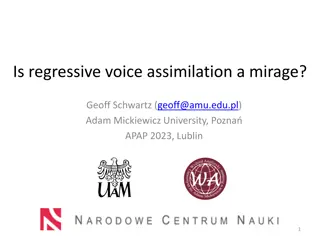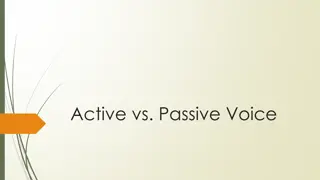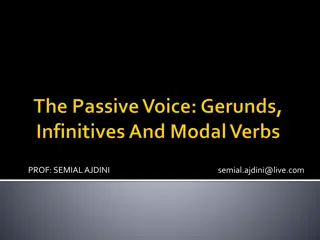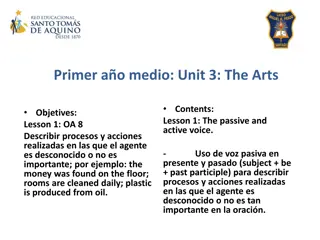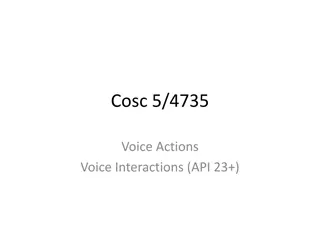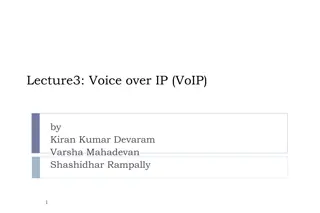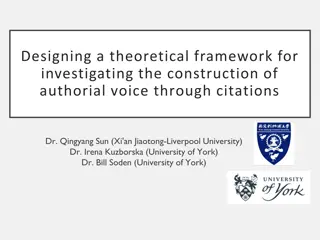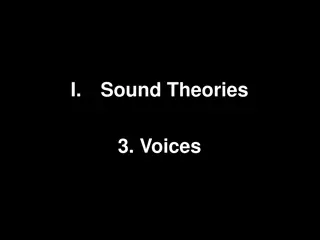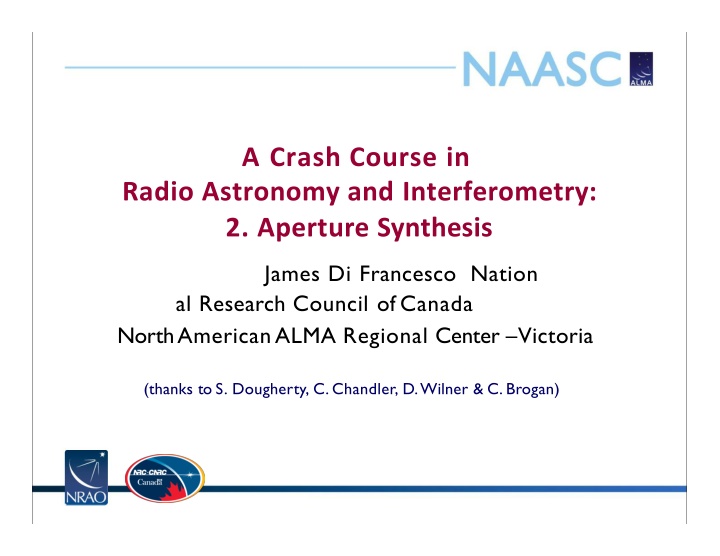
Aperture Synthesis in Radio Astronomy
Explore the concepts of Aperture Synthesis in Radio Astronomy and Interferometry, where signals from multiple antenna elements are combined to enhance resolution and sensitivity. Learn how measurements are made, the basic principles behind Aperture Synthesis, and the benefits it offers in astronomical observations.
Download Presentation

Please find below an Image/Link to download the presentation.
The content on the website is provided AS IS for your information and personal use only. It may not be sold, licensed, or shared on other websites without obtaining consent from the author. If you encounter any issues during the download, it is possible that the publisher has removed the file from their server.
You are allowed to download the files provided on this website for personal or commercial use, subject to the condition that they are used lawfully. All files are the property of their respective owners.
The content on the website is provided AS IS for your information and personal use only. It may not be sold, licensed, or shared on other websites without obtaining consent from the author.
E N D
Presentation Transcript
A Crash Course in Radio Astronomy and Interferometry: 2. Aperture Synthesis James Di Francesco Nation al Research Council ofCanada NorthAmericanALMA Regional Center Victoria (thanks to S. Dougherty, C. Chandler, D. Wilner & C. Brogan)
Aperture Synthesis Output of a FilledAperture Signals at each point in the aperture are brought together in phase at the antenna output (thefocus) Imagine the aperture to be subdivided into N smaller elementary areas; the voltage, V(t), at the output is the sum of thecontributions Vi(t) from the N individual apertureelements: V(t) = Vi(t)
Aperture Synthesis Aperture Synthesis: Basic Concept The radio power measured by a receiver attached to the telescopeis proportional to a running time average of the square of the output voltage: 2 P ( Vi) = ( Vi Vk )= Vi + V V 2 i k i k Any measurement with the large filled-aperture telescope can be written as a sum, in which each term depends on contributions from only two of the N apertureelements Each term Vi Vk can be measured with two small antennas, if we w e place them at locations i and k and measure the average product of their output voltages with a correlation (multiplying)receiver
Aperture Synthesis Aperture Synthesis: Basic Concept If the source emission is unchanging, there is no need to measureall the pairs at one time One could imagine sequentially combining pairsof signals. For N sub-apertures there will be N(N-1)/2 pairs tocombine Adding together all the terms effectively synthesizes one measurement taken with a large filled-aperturetelescope Can synthesize apertures much larger than can be constructed as a filled aperture, giving very good spatialresolution
Aperture Synthesis A Simple 2-Element Interferometer What is the interferometer response as afunction of sky position, l = sin ? In direction s0 ( = 0) the w avefront arriving at teles cope #1 has an extra pat h b s0 =b sin ravel relative to #2 to t The time taken to traverse this extra path is the geometric delay, g= b s0/c This delay is compensated for by inserting a signal path d elay for #2 equivalent to g
Aperture Synthesis Response of a 2-ElementInterferometer At angle , a wavefront has an extra path x = u sin = ul totravel Expand to 2D by introducing orthogonal to , m = sin a nd v orthogonal to u, so th at in this direction the extr a path y = vm Write all distances in units of wavelength, x x/ , y y/ , etc., so that x and y are now numbers of cycles Extra path is now ul + vm V2 = V1e-2 i(ul+vm)
Aperture Synthesis Correlator Output The output from the correlator (the multiplying and time-averaging device) is: C = V1V2= V1(l,m)dldm V2(l,m)dldm For (l1 l2, m1 m2) the above average is zero (assuming mutual sky),so C = V1(l,m)V2 (l,m)dldm = V1(l,m)V2 (l,m) dldm = I(l,m)e 2 i( ul + vm )dldm 1 V (l,m)2e 2 i(ul+vm)dldm =
Aperture Synthesis The Complex Visibility Thus, the interferometer measures the complex visibility, V, of a source, which is the FT of its intensity distribution onthe sky: tf (u,v) =Ae i = I(l,m)e 2 i( ul + vm )dldm u,v are spatial frequencies in the E-W and N-S directions, are the projected baseline lengths measured in units of wavelength, i.e., B/ l, m are direction cosines relative to a reference position in the E-W and N-S directions (l = 0, m = 0) is known as the phasecenter the phase contains information about the location of structure with spatial frequency u,v relative to the phase center
Aperture Synthesis The Complex Visibility This FT relationship is the van Cittert-Zernike theorem, upon which synthesis imaging isbased It means there is an inverse FT relationship that enables usto recover I(l,m) from V(u,v): tf(u,v) = I(l,m)e 2 i(ul+vm)dldm I(l,m) = tf(u,v)e2 i(ul+vm)dudv The correlator measures both real and imaginary parts ofthe visibility to give the amplitude and phase: 2 A = + 2 A=|tf|
Aperture Synthesis The Primary Beam The elements of an interferometer have finite size, and so have their own response to the radiation from the sky This results in an additional factor, A(l,m), to be included in the e xpression for the correlator output, which is the primary beam or normalized reception pattern of the individual elements C = A(l,m)I(l,m)e 2 i( ul + vm )dldm Interferometer actually measures the FT of the sky multiplied by the primary beam response Need to divide by A(l,m) to recover I(l,m), the last step of image production Primary Beam FWHM is the Field-of-View of asingle-pointing interferometric image
Aperture Synthesis The FourierTransform Fourier theory states that any signal (including images) can be expressed as a sum of sinusoids Jean Baptiste Joseph Fourier 1768-1830 signal 4 sinusoids sum (x,y) plane and(u,v) plane are conjugate coordinate systems I(x,y) V(u,v) = FT{I(x,y)} the Fourier Transform contains allinformation of the original
Aperture Synthesis Some 2-D Fourier TransformPairs I(x,y) Amp{V(u,v)} Constant Function Gaussian Gaussian narrow features transform to wide features (and vice-versa)
Aperture Synthesis More 2-D Fourier TransformPairs I(x,y) Amp{V(u,v)} elliptical Gaussian elliptical Gaussian Bessel Disk sharp edges result in many high spatial frequencies
Aperture Synthesis Amplitude and Phase complex numbers: (real, imaginary) or (amplitude,phase) amplitude tells how much of a certain spatial frequency component phase tells where this component islocated I(x,y) Amp{V(u,v)} Pha{V(u,v)}
Aperture Synthesis Amplitude and Phase complex numbers: (real, imaginary) or (amplitude,phase) amplitude tells how much of a certain spatial frequency component phase tells where this component islocated I(x,y) Amp{V(u,v)} Pha{V(u,v)}
Aperture Synthesis Picturing the Visibility:Fringes The FT of a single visibility measurement is a sinusoid with spacing 1/u = /B between successive peaks, or fringes Build up an image of the sky by summing many such sinusoids (addition theorem) FT scaling theorem shows: Short baselines have large f ringe spacings and measure large-scale structure on thesky Long baselines have small frin ge spacings and measure smal l-scale structure on thesky /B rad. Source b rightness - + - + - + - Fringe Sign
Aperture Synthesis Aperture Synthesis sample V(u,v) at enough points to synthesize the equivalentlarge aperture of size (umax,vmax) 1 pair of telescopes 1 (u,v) sample at a time N telescopes number of samples = N(N-1)/2 fill in (u,v) plane by making use of Earth rotation: Martin Ryle, 1974 Nobel Prize inPhysics reconfigure physical layout of N telescopesfor more Sir Sir Martin Ryle 1918-1984 2 configurations of 8 SMA antennas 345 GHz Dec = -24 deg 17
Next: Interferometric Imaging

